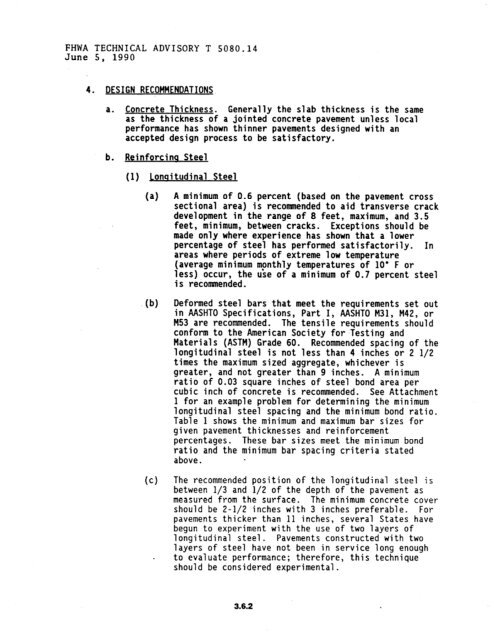chapter 3 rigid pavement - DOT On-Line Publications - Department ...
chapter 3 rigid pavement - DOT On-Line Publications - Department ...
chapter 3 rigid pavement - DOT On-Line Publications - Department ...
Create successful ePaper yourself
Turn your PDF publications into a flip-book with our unique Google optimized e-Paper software.
FHWA TECHNICAL ADVISORY T 5080.14<br />
June 5, 1990<br />
4. DESIGN RECOMMENDATIONS<br />
a. Concrete Thickness. Generally the slab thickness is the same<br />
as the thickness of a jointed concrete <strong>pavement</strong> unless local<br />
performance has shown thinner <strong>pavement</strong>s designed with an<br />
accepted design process to be satisfactory.<br />
b. Reinforcina Steel<br />
(1) Lonaitudinal Steel<br />
(a)<br />
@I<br />
w<br />
A minimum of 0.6 percent (based on the <strong>pavement</strong> cross<br />
sectional area) is reconnnended to aid transverse crack<br />
development in the range of 8 feet, maximum, and 3.5<br />
feet, minimum, between cracks. Exceptions should be<br />
made only where experience has shown that a lower<br />
percentage of steel has performed satisfactorily. In<br />
areas where periods of extreme low temperature<br />
(average minimum mpnthly temperatures of 10’ F or<br />
less) occur, the use of a minimum of 0.7 percent steel<br />
is recommended.<br />
Deformed steel bars that meet the requirements set out<br />
in AASHTO Specifications, Part I, AASHTO M31, M42, or<br />
M53 are recommended. The tensile requirements should<br />
conform to the American Society for-Testing and<br />
Materials (ASTM) Grade 60. Recommended spacing of the<br />
longitudinal steel is not less than 4 inches or 2 l/2<br />
times the maximum sized aggregate, whichever is<br />
greater, and not greater than 9 inches. A minimum<br />
ratio of 0.03 square inches of steel bond area per<br />
cubic inch of concrete is recommended. See Attachment<br />
1 for an example problem for determining the minimum<br />
longitudinal steel spacing and the minimum bond ratio.<br />
Table 1 shows the minimum and maximum bar sizes for<br />
given <strong>pavement</strong> thicknesses and reinforcement<br />
percentages. These bar sizes meet the minimum bond<br />
ratio<br />
above.<br />
and the minimum<br />
.<br />
bar spacing criteria stated<br />
The recommended position of the longitudinal steel is<br />
between l/3 and l/2 of the depth of the <strong>pavement</strong> as<br />
measured from the surface. The minimum concrete cover<br />
should be 2-l/2 inches with 3 inches preferable. For<br />
<strong>pavement</strong>s thicker than 11 inches, several States have<br />
begun to experiment with the use of two layers of<br />
longitudinal steel. Pavements constructed with two<br />
layers of steel have not been in service long enough<br />
to evaluate performance; therefore, this technique<br />
should be considered experimental.<br />
3.6.2
















